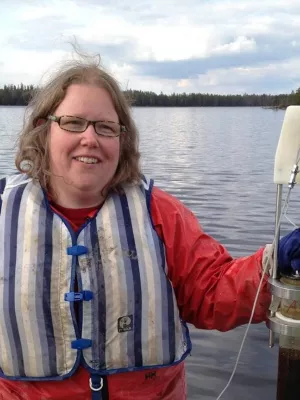
Anne Nielsen
Projektkoordinator

Relative pollen productivity estimates in the forest steppe landscape of southeastern Romania
Författare
Summary, in English
Estimates of relative pollen productivity (RPP) represent key input parameters for model-based quantitative reconstructions of past vegetation cover. In this study, we provide the first RPP estimates for 13 taxa from the forest steppe ecoregion in southeastern Romania (southeastern Europe). We used modern pollen assemblages from 26 points together with vegetation surveys and mapping, covering a 1.5 km radius around each sampling site. We have estimated the relevant source area of pollen (RSAP) and pollen productivity for 13 taxa relative to Poaceae using the ERV (Extended R-value model), sub-model 3, as this model shows the best goodness of fit. The estimated RSAP is about 100 m and falls within the range of RSAP estimates of moss pollsters and forest hollows from other RPP-related studies. Results show that Rubiaceae (7.97), Apiaceae (5.91), Artemisia (5.89) and Fraxinus (2.99) are high pollen producers compared to Poaceae, while Plantago lanceolata (0.58), Fabaceae (0.40), Acer (0.30), Rosaceae (0.29), Carpinus orientalis (0.24), Cerealia (0.22) and Asteraceae (0.16) are low pollen producers with lower RPPs than Poaceae. Quercus (1.10) has a pollen productivity close to that of Poaceae. The RPPs for Carpinus orientalis and Fabaceae are published here the first time for Europe. The high pollen producing plants include both entomophilous and anemophilous species, while the low pollen producers are mostly entomophilous species. Our results form an essential contribution to improving the accuracy of quantitative reconstruction of forest steppe ecoregion in Europe and generally in regions with a similar climate and vegetation setting.
Avdelning/ar
- Kvartärgeologi
- BECC: Biodiversity and Ecosystem services in a Changing Climate
- MERGE: ModElling the Regional and Global Earth system
Publiceringsår
2019
Språk
Engelska
Sidor
54-63
Publikation/Tidskrift/Serie
Review of Palaeobotany and Palynology
Volym
264
Länkar
Dokumenttyp
Artikel i tidskrift
Förlag
Elsevier
Ämne
- Botany
Nyckelord
- Extended R-value model
- Forest steppe
- Relative pollen productivity estimates
- Relevant source area of pollen
- Southeastern Romania
Status
Published
Projekt
- PAGES’ LandCover6k Working Group
ISBN/ISSN/Övrigt
- ISSN: 0034-6667

